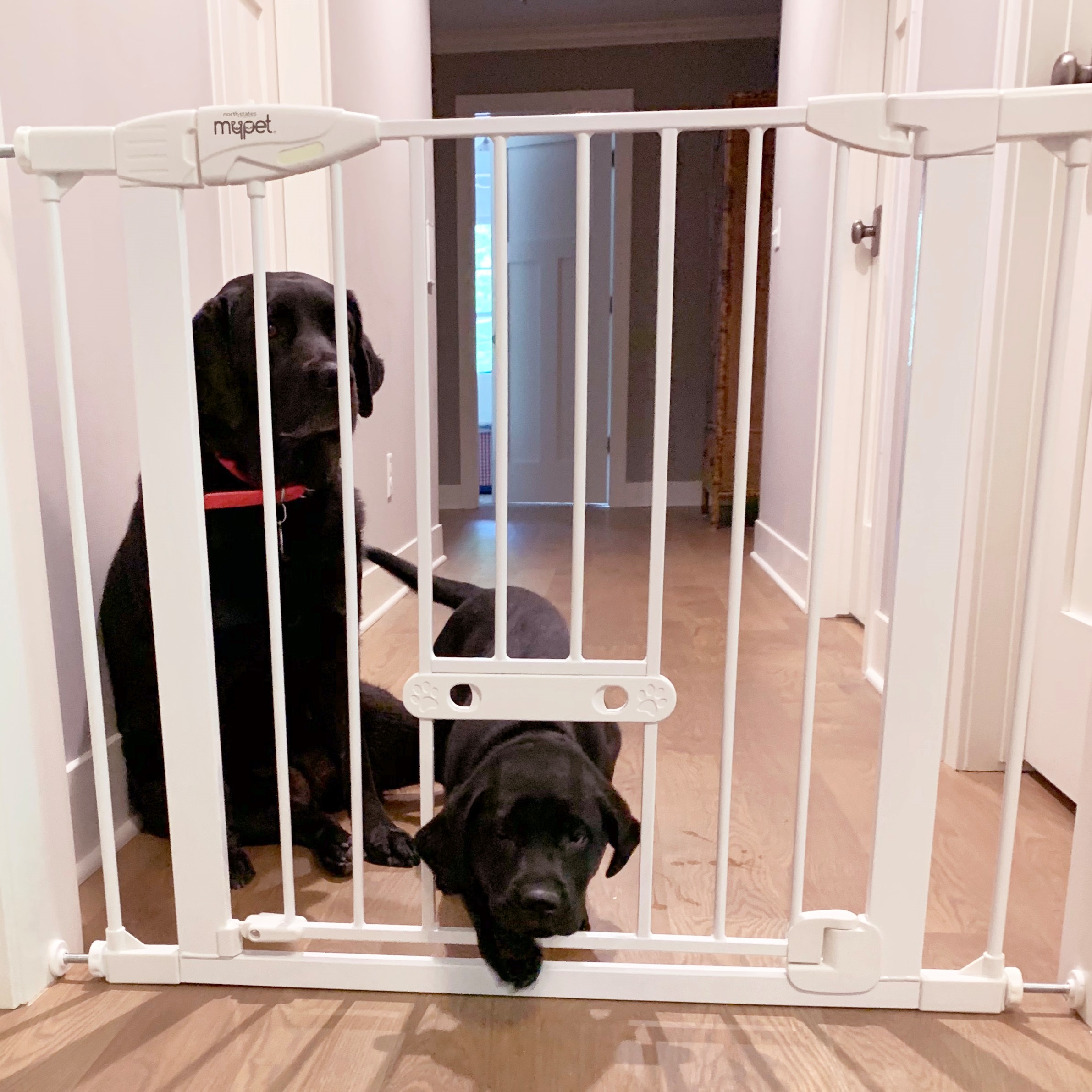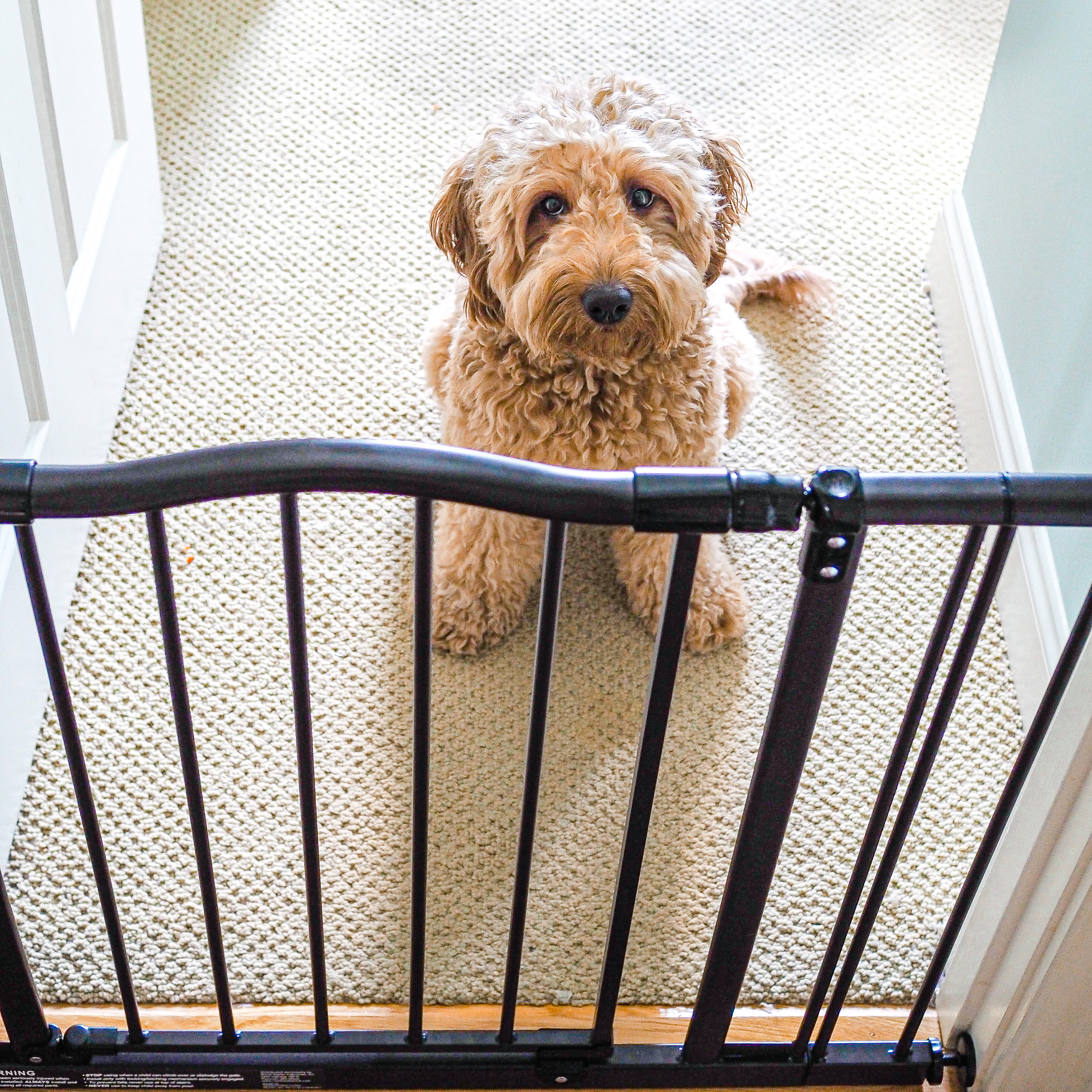How to Use Pet Gates in Your Home
Jan 27th 2021
Why a pet gate might be right for your home, how to choose the best one, and training tips for how to use it.

Photo Credit: Wall-E the Retriever
Whether you have a new puppy or are moving into a new home, you might be wondering if a dog gate is right for you. Pet gates can be amazing training tools in many different situations, and they can help your pets feel safe in their environment. Dogs don’t always follow humans’ house rules, but with patience and training, boundaries can be set that will make everyone in the family’s lives easier.
Why You Should Consider a Pet Gate
There are many different reasons you might wish to use a pet gate in your home. Gates can be an effective way to train your dog and prevent them from practicing unwanted behaviors in the house. Keep in mind that although it may feel like you are shutting out your pets, a gate can be an important tool in keeping your pet safe, restricting access to dangerous areas in your home, and providing them with a safe space of their own. Here are a few scenarios where a dog gate might be the best solution for your family:
Keeping Them in One Area of Your Home
Maybe you want to keep your pup away from your new carpets or the dangers of the kitchen. Either way, a pet gate can help keep your pets confined to one room or area in your house. It could be a mudroom, bedroom, or living space, and the gate can help prevent your pet from getting into the trash, chewing on furniture, or having accidents on the carpets and rugs
Giving Them Their Own Safe Space
It’s important for pets to have a space that feels like home! Many pet owners will start out with a crate for their puppy, and then their pup can graduate to a larger space such as a pet yard or a room blocked off with a pet gate. Make sure this space is also where they have access to food, water, their bed, and their favorite toys. Your pet can also benefit from having their own space because it helps build independence. Separation anxiety and stress can be bad for your pup’s health, and practicing alone time in your pup’s safe space can better prepare them for when you are away from home.
Separating Them From Others
Gates can be a great solution if you want to keep your pet separated from others in some way. Many families with both dogs and cats will want to keep their dog from getting into the litterbox, and gates with a small door can allow the cat to get to it while keeping the dog out. Other families will want to keep their dog away from the front door so that if a visitor stops by, the dog won’t bombard them or escape from home.


Next Step After Crate Training
Many new dog owners will decide to crate train their pup, but after awhile you may want to wean your pup out of the crate and into a bigger space. This will be helpful if you have a high energy or big dog, as gating them in a larger area will give them more room to run and play during the day. It’s best to start off small by gating your pup in a small area such as a mudroom or other safe area in your house. Then later on you can expand their contained area, and eventually you can only block off certain areas of your home that you don’t want them getting into.
How to Choose the Best Gate for You and Your Pets
There are thousands of different gates out there, and there are many factors to keep in mind when selecting a gate for your home. Of course, safety is the number one concern of pet owners, so make sure the gate you select won’t fall over, won’t be climbed by your pup, and won’t cause a choking hazard in the case of a chewer. To get a better sense of your options, check out the factors to consider below:
Mounting Type
There are three different types of gates to choose from: hardware-mounted, pressure-mounted, and freestanding enclosures. A hardware-mounted gate uses permanent hardware to be installed into a wall stud or door frame, and is extra secure and sturdy. On the flip side, a pressure-mounted gate does not require tools or hardware and uses pressure to keep the gate secure. A freestanding enclosure can stand on its own and doesn’t need to fit into a doorway or mount to any walls. Whether you rent or own your home may be a factor in which gate to consider.
Location
Where you plan to use a gate may affect which gates you consider. If you plan on using a gate between rooms and hallways, you can select between a gate that has a walk-through door (like the Windsor Arch Petgate) or one that is easily moved to different locations (like the Paws Portable Petgate). If you are using a gate at the top of the stairs, make sure the gate does not swing out over the stairs, and make sure it is hardware mounted to the wall for sturdiness. Blocking off a large area or room can be a snap with an extra-wide gate or Petyard with a wall-mount kit.

Photo Credit: Jess Crimaldi
Size
In order for your gate to be effective, you must consider both the size of your doorway and the size of your dog. Any doorway, opening, or room can be blocked off with a gate, but you will need to measure the size of gate you need before selecting the perfect one. The adult size of your dog should also be considered—get an extra tall gate from the start if you have a large breed dog, and a shorter gate may be used if you have a small breed dog.
Material
If you plan to use your gate both indoors and outdoors, a plastic gate will be ideal to avoid rust due to weather conditions (but we don’t recommend storing plastic gates in temperatures under 40 degrees F). However, if your pet is prone to chewing, a metal gate will have better durability.
Multiple Pets
As mentioned above, some families may wish to block a certain area from their dogs while allowing smaller pets to get through. These families should look for a gate with a small cat door so that their smaller pets can roam freely.
Décor
Training Tips for Pet Gates
Once your ideal gate is determined and installed, it’s time to train your pup how to use it! The most important advice for training a new pup is to reward them for good behavior, and don’t reward them for bad behavior so they know what not to do. Here are some tips for training your pets with gates:
House Training
Before bringing your dog into their enclosed space, take them outside to do their business. After you put them inside the crate or enclosed space, give them treats to reward their behavior. Keep a close eye on them and keep them on a consistent schedule. Always be patient and keep a calm, relaxed attitude. Potty training takes time, so don’t worry if your pup is still having accidents inside the house. You can read more about potty training techniques from the American Kennel Club.
Introducing Pets to Being Gated
Your pup might not love being separated from their pack at first, but with effective training, they will get used to it! Bring your pup into the gated area and give them treats and lots of attention for good behavior. Bad behavior, such as climbing on the gate, whining, barking, or begging for attention, should not be rewarded. At first, stay close by so they know you aren’t too far away. In time, your pup will get used to being in their own space and will be calm and relaxed when you leave.
Training Small Pets to Use the Small Door
If you purchase a gate that has a small door so your cats and small pets can get through, you’ll have to train them to use that small door at first. Lifting the door up yourself and luring them with treats on the other side will be a great way to start getting them used to using it. After awhile, they will do it on their own!
Learn more about the basics of selecting the best gate for your home on our Gate Basics page.
